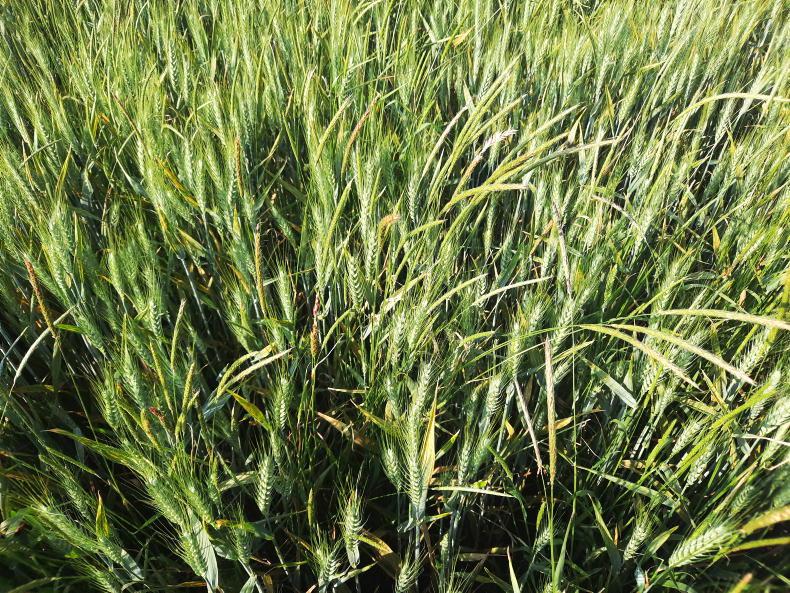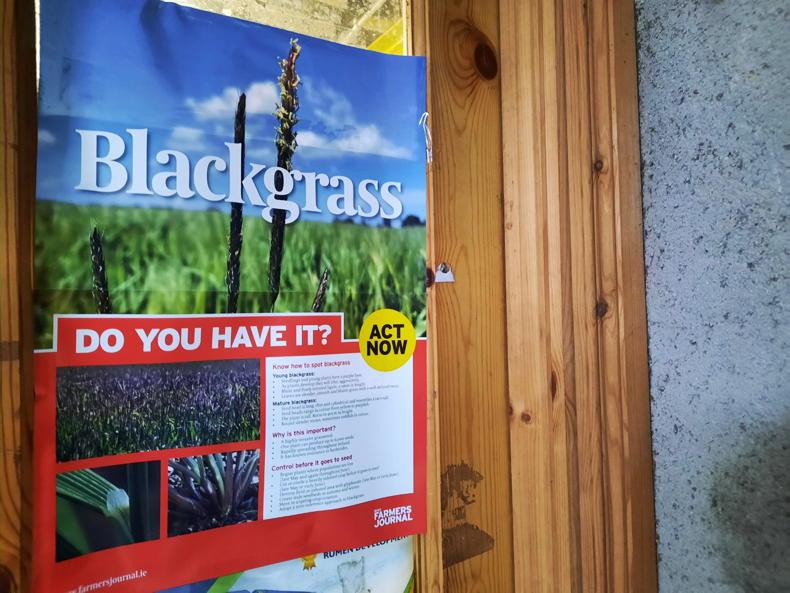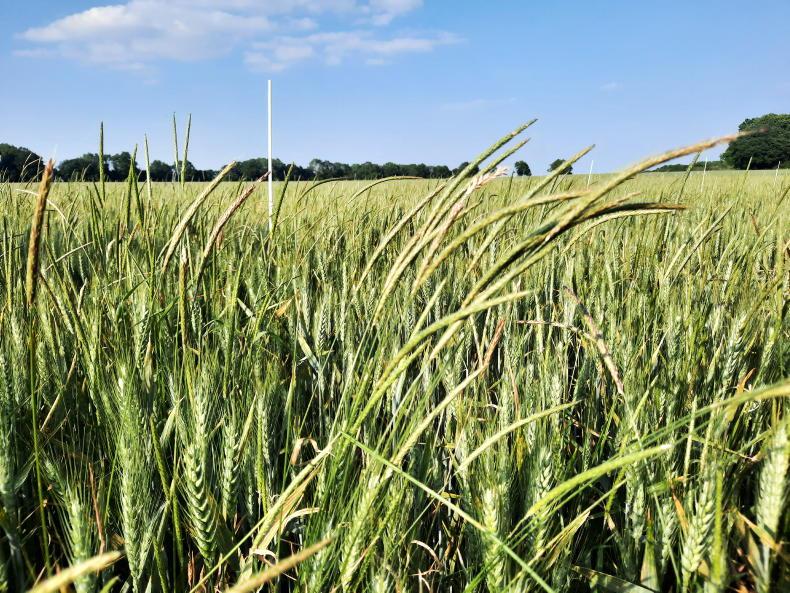Meadow grass, spring wild oats and bromes are the most common grass weeds on our tillage farms (Figure 1 A-C), but critical species such as blackgrass, Italian ryegrass or lesser canary grass, although not present on every farm, are increasing (Figure 1 D-F).

Figure 1. Maps showing the distribution of grass weeds using data from a nationwide survey (2020 and 2021) and industry-submitted samples from 2019 to 2024.
Teagasc has been monitoring herbicide resistance to ACCase (eg, Axial) and ALS (eg, Pacifica Plus) herbicides since 2019. Resistance-suspect populations were submitted by growers and advisers, and a nationwide survey of grass weeds in 2021/2022 also provided samples for analysis. While the proportion (%) of these samples found to be resistant in each grass type is not an estimate of resistance in all arable fields, it does indicate how prevalent resistance can be in each type.
Of the 274 field populations of wild oats, blackgrass, Italian ryegrass and meadow grasses tested, 49% were resistant (Figure 2). No brome (>130 samples tested) or canary grass (>30 tested) samples were found to be fully resistant so far.
Importantly, the 2024 sample analysis of blackgrass and Italian ryegrass is not yet complete, and the ongoing analysis is likely to result in even more resistant cases.
Understanding the scale of the resistance issue and the underlying mechanism is critical for developing strategies to deal with it.
1 Spring wild oats
57 out of 168 (34%) populations tested were ACCase-resistant (Figure 2).Three different target-site resistance (TSR) mutations were frequently associated with this resistance. Depending on the mutation, populations were resistant to Axial, Falcon and Stratos, or to Axial and Falcon, or to Falcon only.No evidence of wild oats resistance to ALS-Pacifica or Broadway Star to date.2 Blackgrass
31 out of 49 (63%) populations tested were resistant; 25 were resistant to both ACCase and ALS, four were ACCase-resistant only, and two were ALS-resistant only (Figure 2). Specific types of TSR mutations resulted in resistance to ACCase-Falcon and Stratos but not necessarily, Centurion Max.Double mutations were frequently associated with ALS-Pacifica resistance. 3 Italian ryegrass
29 out of 37 (78%) populations tested were resistant; 19 were resistant to both ACCase and ALS and 10 were ALS-resistant only (Figure 2).TSR analysis showed no known ACCase or ALS mutations in most populations, which more than likely, indicates non-target-site resistance (NTSR). For ACCase, specific TSR mutations affect almost all herbicides from the ACCase group, including Axial, Falcon, Stratos and Centurion Max.For ALS, two common mutations were frequently associated with ALS-Pacifica and Broadway Star resistance.
4 Meadow grass
18 out of 20 (90%) populations tested were ALS-resistant (Figure 2). Note: these were all suspected of resistance.
Figure 2. Maps showing the known prevalence of herbicide-resistant grass weeds.
Two common mutations cause ALS-Pacifica resistance.It is of note that annual meadow grass is naturally tolerant to some ACCase herbicides (excluding Centurion Max). So what can we do?
Wild oats
Before resistance evolves, every field that is sprayed with ‘Axial’ or similar should be hand rogued, as the ‘escapees’ from herbicide treatment will include the first herbicide resistant plants that will become a resistant population.
Annual meadow grass
Always use a pre-emerge or autumn residual herbicide in winter cereals (eg flufenacet, prosulfocarb, etc), particularly if you intend to use an ALS (eg, Pacifica or Broadway) for brome control later, as it will avoid exposing meadow grass to unnecessary selection pressure from the ALS herbicide.
Blackgrass and Italian ryegrass
Drastic action needs to be taken if you find these weeds on your farm. Living with them is not an option. Hand rogue or destroy complete crop areas as appropriate to eliminate seed return and develop a follow-up plan.
All weeds
As herbicide availability and effectiveness declines, we must adopt/consider every non-herbicide action to reduce the weed challenge. No easy task, but the sooner we start, the better!
Meadow grass, spring wild oats and bromes are the most common grass weeds on our tillage farms (Figure 1 A-C), but critical species such as blackgrass, Italian ryegrass or lesser canary grass, although not present on every farm, are increasing (Figure 1 D-F).

Figure 1. Maps showing the distribution of grass weeds using data from a nationwide survey (2020 and 2021) and industry-submitted samples from 2019 to 2024.
Teagasc has been monitoring herbicide resistance to ACCase (eg, Axial) and ALS (eg, Pacifica Plus) herbicides since 2019. Resistance-suspect populations were submitted by growers and advisers, and a nationwide survey of grass weeds in 2021/2022 also provided samples for analysis. While the proportion (%) of these samples found to be resistant in each grass type is not an estimate of resistance in all arable fields, it does indicate how prevalent resistance can be in each type.
Of the 274 field populations of wild oats, blackgrass, Italian ryegrass and meadow grasses tested, 49% were resistant (Figure 2). No brome (>130 samples tested) or canary grass (>30 tested) samples were found to be fully resistant so far.
Importantly, the 2024 sample analysis of blackgrass and Italian ryegrass is not yet complete, and the ongoing analysis is likely to result in even more resistant cases.
Understanding the scale of the resistance issue and the underlying mechanism is critical for developing strategies to deal with it.
1 Spring wild oats
57 out of 168 (34%) populations tested were ACCase-resistant (Figure 2).Three different target-site resistance (TSR) mutations were frequently associated with this resistance. Depending on the mutation, populations were resistant to Axial, Falcon and Stratos, or to Axial and Falcon, or to Falcon only.No evidence of wild oats resistance to ALS-Pacifica or Broadway Star to date.2 Blackgrass
31 out of 49 (63%) populations tested were resistant; 25 were resistant to both ACCase and ALS, four were ACCase-resistant only, and two were ALS-resistant only (Figure 2). Specific types of TSR mutations resulted in resistance to ACCase-Falcon and Stratos but not necessarily, Centurion Max.Double mutations were frequently associated with ALS-Pacifica resistance. 3 Italian ryegrass
29 out of 37 (78%) populations tested were resistant; 19 were resistant to both ACCase and ALS and 10 were ALS-resistant only (Figure 2).TSR analysis showed no known ACCase or ALS mutations in most populations, which more than likely, indicates non-target-site resistance (NTSR). For ACCase, specific TSR mutations affect almost all herbicides from the ACCase group, including Axial, Falcon, Stratos and Centurion Max.For ALS, two common mutations were frequently associated with ALS-Pacifica and Broadway Star resistance.
4 Meadow grass
18 out of 20 (90%) populations tested were ALS-resistant (Figure 2). Note: these were all suspected of resistance.
Figure 2. Maps showing the known prevalence of herbicide-resistant grass weeds.
Two common mutations cause ALS-Pacifica resistance.It is of note that annual meadow grass is naturally tolerant to some ACCase herbicides (excluding Centurion Max). So what can we do?
Wild oats
Before resistance evolves, every field that is sprayed with ‘Axial’ or similar should be hand rogued, as the ‘escapees’ from herbicide treatment will include the first herbicide resistant plants that will become a resistant population.
Annual meadow grass
Always use a pre-emerge or autumn residual herbicide in winter cereals (eg flufenacet, prosulfocarb, etc), particularly if you intend to use an ALS (eg, Pacifica or Broadway) for brome control later, as it will avoid exposing meadow grass to unnecessary selection pressure from the ALS herbicide.
Blackgrass and Italian ryegrass
Drastic action needs to be taken if you find these weeds on your farm. Living with them is not an option. Hand rogue or destroy complete crop areas as appropriate to eliminate seed return and develop a follow-up plan.
All weeds
As herbicide availability and effectiveness declines, we must adopt/consider every non-herbicide action to reduce the weed challenge. No easy task, but the sooner we start, the better!












SHARING OPTIONS